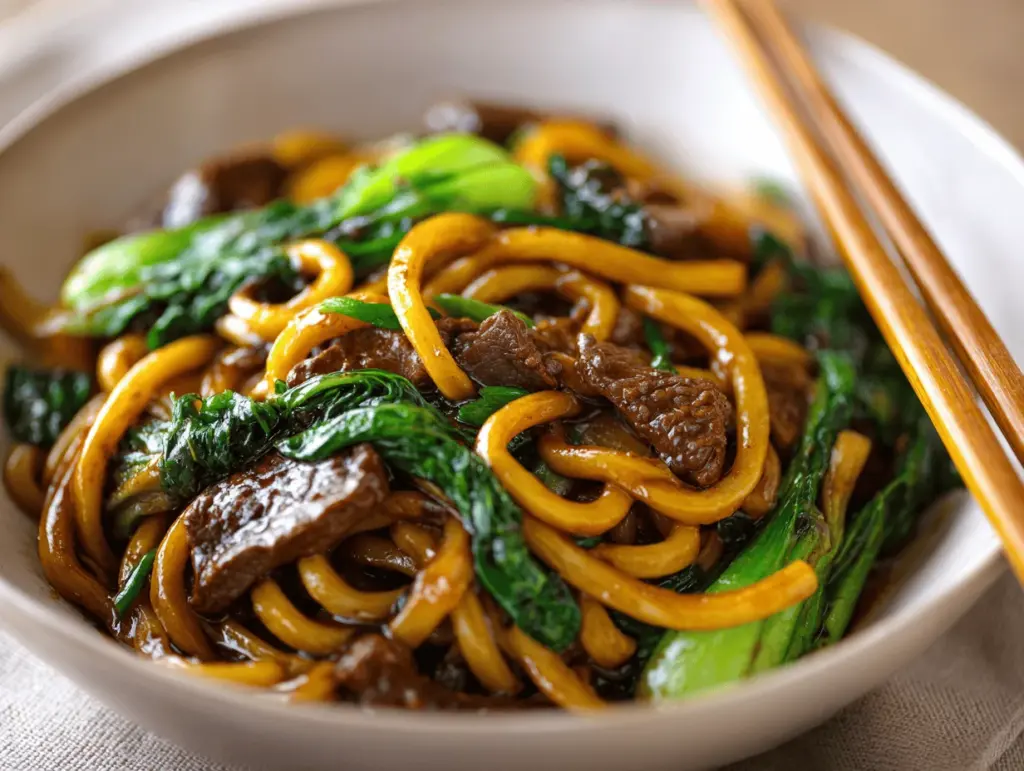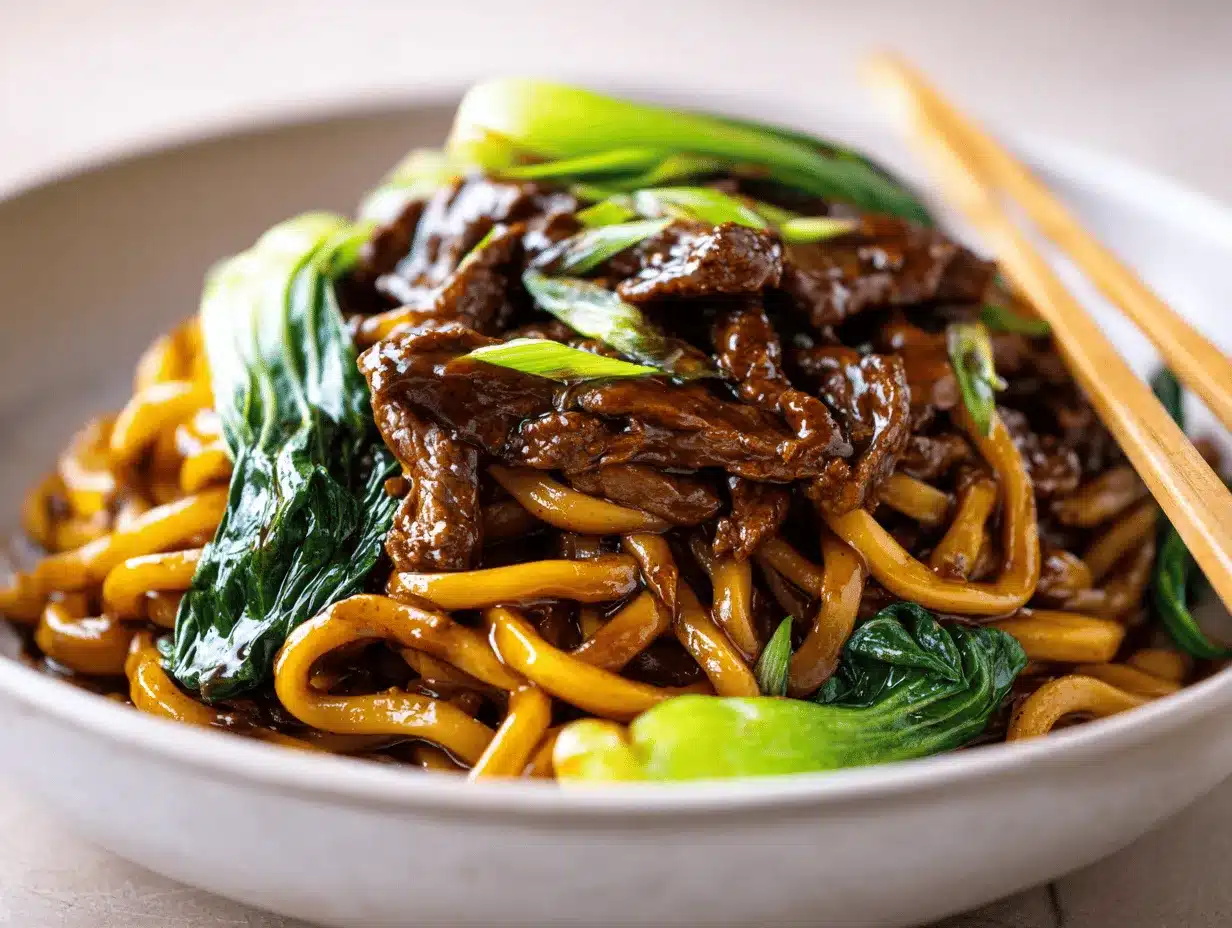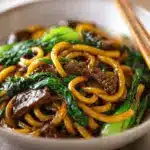The sizzle of tender beef hitting a hot pan, the punchy aroma of crushed black pepper, and glossy udon noodles slicked with savory sauce—if that doesn’t have you hungry already, I don’t know what will. Honestly, my Beef Black Pepper Udon is the kind of recipe that turns an ordinary night into something a little more special (without a ton of effort). I first fell in love with this dish on a rainy night in Tokyo, ducking into a tiny noodle shop where the chef cooked everything right in front of us. That memory stuck with me so much that I knew I had to bring it home and, well, make it doable for busy weeknights.
I’ve made this beef black pepper udon more times than I can count—sometimes with a splash of extra soy, sometimes with a handful of veggies tossed in. What I love most? It’s fast, packed with flavor, and you only need one pan. You can whip it up in about 20 minutes, so there’s no excuse not to treat yourself. It’s my go-to for when friends pop by unexpectedly or when I need comfort food after a long day. Trust me, once you taste those chewy noodles soaking up that peppery beef sauce, you’ll want to put this on repeat.
This recipe is perfect for anyone craving takeout vibes at home, or families needing a dinner that even picky eaters will devour. It’s got that restaurant-quality feel, but you control the ingredients (and the spice!). If you’re into Asian noodles, bold flavors, or just want a meal that’ll make you look like a kitchen rockstar without the stress, this beef black pepper udon is for you. As someone who’s played around with different versions, I can guarantee—you’ll want to save this one.
Why You’ll Love This Beef Black Pepper Udon Recipe
- Quick & Easy: Ready in just 20 minutes—seriously, you’ll spend more time waiting for delivery than making these noodles.
- Simple Ingredients: No hunting down hard-to-find sauces or spices. Most of these are pantry staples, and you can find fresh udon noodles at most grocery stores these days.
- Perfect for Weeknights or Impressing Guests: Whether you’ve got a busy night ahead or want to dazzle your friends with something other than the usual stir fry, this recipe’s got your back.
- Crowd-Pleaser: Kids, adults, picky eaters—everyone loves chewy noodles and savory beef. I’ve never had leftovers last more than a day.
- Unbelievably Delicious: That combo of black pepper heat, umami-rich soy, and sweet onions? It’s the kind of flavor that has you going back for “just one more bite.”
What sets this beef black pepper udon apart from the rest? For starters, I use a blend of coarsely cracked and finely ground black pepper—this gives the dish layers of flavor instead of just heat. Blanching the udon before stir-frying keeps the noodles perfectly chewy (not mushy, not tough). And the sauce? It’s glossy, rich, and clings to every noodle and piece of beef. I’ve tried shortcuts and fancier versions, but this is the one I always come back to.
This isn’t just another noodle bowl. It’s comfort food, but a little lighter and a lot more flavorful than greasy takeout. It’s the kind of meal that makes people ask for the recipe. For me, there’s something so satisfying about tossing everything together in one pan and watching the magic happen. You can tweak the spice, swap in different proteins, or toss in what’s in your fridge—this recipe is as flexible as it is tasty. If you crave those bold, peppery Asian flavors, this beef black pepper udon is about to become your new obsession.
What Ingredients You Will Need
This beef black pepper udon recipe keeps things simple, relying on classic Asian ingredients and a few fresh pantry staples. Here’s what you’ll need to make it happen:
- For the Beef & Marinade:
- 8 oz (225g) beef sirloin or ribeye, thinly sliced (choose well-marbled cuts for max tenderness; flank steak works too)
- 1 tbsp soy sauce (I like Kikkoman for a balanced flavor)
- 1 tsp cornstarch (helps the beef stay juicy and tender)
- 1 tsp toasted sesame oil (adds nutty depth)
- For the Noodles:
- 14 oz (400g) fresh udon noodles (or 7 oz/200g dried udon—just cook according to package and rinse well)
- For the Black Pepper Sauce:
- 2 tbsp oyster sauce (Lee Kum Kee is my go-to; adds umami and a hint of sweetness)
- 1 tbsp dark soy sauce (for color and depth; use regular soy if that’s what you have)
- 2 tsp freshly ground black pepper (use a mix of coarse and fine grinds for best results)
- 1 tbsp light soy sauce (for saltiness and balance)
- 1 tsp sugar (balances out the pepper and salt)
- 2 tbsp water
- Vegetables & Aromatics:
- 1 medium yellow onion, sliced (sweetness and crunch)
- 2-3 cloves garlic, minced (don’t be shy—it makes the sauce sing)
- 1/2 red bell pepper, sliced thin (optional, but adds color and a subtle sweetness)
- 2 green onions, sliced (for garnish and a fresh bite)
- Other:
- 1-2 tbsp neutral oil (canola or grapeseed; for high-heat stir-frying)
- Extra black pepper for finishing
- Optional: toasted sesame seeds, chili flakes, or sliced chili for topping
Ingredient Tips: When buying beef, look for thin slices—many Asian markets sell it pre-sliced for hot pot or stir-fries, which saves a ton of prep time. For udon, the vacuum-packed fresh style is chewy and holds up best, but dried works in a pinch. If you’re gluten-free, swap soy sauces for tamari and use rice noodles (it won’t be classic udon, but still tasty!). Out of oyster sauce? Hoisin sauce can stand in, though it’s sweeter. Don’t stress over perfection—this recipe is forgiving and loves improvisation.
Equipment Needed
- Large non-stick skillet or wok: A wok is traditional and gives great heat, but a 12-inch skillet works just as well if that’s what you have. Cast iron is a bonus for browning.
- Pot for boiling noodles: If using dried or frozen udon, you’ll need a pot of boiling water. For fresh, just a quick rinse in hot water is enough.
- Sharp chef’s knife: For slicing beef and veggies thin—honestly, a sharp knife makes all the difference for even cooking.
- Cutting board: Wood or plastic, as long as it’s sturdy.
- Tongs or chopsticks: For tossing noodles and beef together (I swear by my silicone-tipped tongs for not scratching pans).
- Mixing bowls: A small one for marinating beef, and another for mixing up the sauce.
- Measuring spoons and cups: For saucy accuracy, but eyeballing works in a pinch!
If you don’t have a wok, don’t worry—I made this in a regular skillet for years. Just preheat it well and don’t overcrowd. For easier clean-up, use non-stick or stainless steel. And if you’re on a budget, most of this equipment can be found at discount stores (I got my favorite wok for under $20!). Keep your knife sharp; it’ll make prepping those veggies way more fun and safe.
Preparation Method
-
Marinate the Beef (5 minutes):
- In a bowl, combine 8 oz (225g) thinly sliced beef with 1 tbsp soy sauce, 1 tsp cornstarch, and 1 tsp sesame oil.
- Toss to coat well and set aside while you prep everything else. This quick marinade tenderizes the beef and adds a savory base.
Tip: Slice beef against the grain for the most tender bite. If your beef is too thick, pop it in the freezer for 10-15 minutes before slicing.
-
Prepare the Udon Noodles (5 minutes):
- If using fresh udon, rinse in hot water to separate. For dried, cook in boiling water per the package (usually 8-10 minutes), then drain and rinse under cold water to stop the cooking. Set aside.
Troubleshooting: Don’t overcook—noodles should be chewy, not mushy. If they stick together, toss with a splash of oil.
-
Stir-Fry the Beef (2-3 minutes):
- Heat 1 tbsp oil in a wok or large skillet over high heat until shimmering.
- Add marinated beef in a single layer. Sear without moving for 30-40 seconds to get a good sear, then stir-fry for another minute until just browned.
- Remove beef to a plate. (Don’t overcook—it’ll finish in the sauce.)
Sensory cue: You want a hint of char on the beef edges. If the pan isn’t hot enough, the beef will steam instead of sear.
-
Sauté Aromatics & Veggies (2-3 minutes):
- In the same pan, add another 1/2 tbsp oil if needed. Toss in sliced onion and bell pepper. Stir-fry until just softened and fragrant.
- Add minced garlic and cook for 30 seconds, until you smell that garlicky punch.
-
Make the Black Pepper Sauce (1 minute):
- In a small bowl, whisk together 2 tbsp oyster sauce, 1 tbsp dark soy sauce, 2 tsp freshly ground black pepper, 1 tbsp light soy sauce, 1 tsp sugar, and 2 tbsp water.
Note: Taste and adjust black pepper to your spice preference—sometimes I add an extra half-teaspoon for more kick.
-
Combine Everything (3-4 minutes):
- Add drained udon noodles to the pan with veggies. Pour sauce over top and toss to coat.
- Return beef to the pan and stir-fry everything together for 2-3 minutes until noodles are glossy and heated through. Sauce should cling to the noodles and beef.
- Toss in green onions, plus extra pepper if you’re like me and love that bold flavor.
Sensory cue: Noodles should be shiny, beef just cooked through, and everything smelling peppery and savory.
-
Serve (1 minute):
- Divide noodles and beef between bowls. Top with sesame seeds, extra green onions, and a sprinkle of chili if you like heat.
Personal tip: Serve immediately for best texture. This dish doesn’t like to wait around—it’s best piping hot!
Efficiency tip: Prep all ingredients before you start cooking (mise en place makes stir-fries a breeze). If you’re juggling tasks, marinate the beef while boiling noodles. And don’t stress if you only have one type of soy sauce—use what’s on hand and adjust to taste.
Cooking Tips & Techniques
- Get the Pan Hot: Wok cooking is all about high heat. Heat your pan until it just starts to smoke before adding oil. This gives you that signature “wok hei” flavor and keeps beef from sticking.
- Don’t Crowd the Pan: If your pan is too full, beef and veggies will steam instead of sear. If doubling the recipe, cook the beef in batches.
- Timing is Everything: Udon noodles are best when they’re chewy and just-cooked. Don’t leave them in the pan too long or they’ll get mushy. I learned this the hard way after one too many soggy noodle attempts!
- Use Freshly Cracked Black Pepper: Pre-ground pepper just doesn’t have the same punch. I use a mortar and pestle or my pepper mill on a coarse setting for that bold flavor.
- Taste and Adjust: Everyone’s salt and spice tolerance is different. Taste the sauce before adding to the pan. Add more soy for salt, more sugar for balance, or extra black pepper for heat.
- Multitasking Strategy: While the beef marinates, slice your onions and peppers. Have everything ready before you start stir-frying, because it comes together fast!
- Common Mistakes: Overcooking the beef (it gets tough), using noodles that are too soft, or not enough sauce. If you notice anything sticking or burning, lower your heat slightly and add a splash of water.
- Personal Oops: Once, I tried to shortcut with pre-minced garlic from a jar. The flavor just wasn’t the same—fresh garlic makes a huge difference!
Consistency comes from practice, but also from prepping your ingredients and trusting your senses. Smell, sight, and taste are your best tools here. Once you get the hang of it, whipping up beef black pepper udon becomes second nature. And if you mess up? Well, it’s still noodles and beef—it’ll be tasty no matter what!
Variations & Adaptations
- Chicken or Shrimp Black Pepper Udon: Swap the beef for thinly sliced chicken breast or peeled shrimp. Chicken cooks in about 3-4 minutes, shrimp in just 2 minutes until pink and opaque.
- Vegetarian Version: Skip the beef and load up on mushrooms (shiitake or oyster are awesome), tofu cubes, and extra veggies. Use mushroom oyster sauce or vegetarian stir-fry sauce.
- Spicy Black Pepper Udon: Add sliced red chili or a spoonful of chili crisp to the sauce for an extra fiery kick. I like to sprinkle some Korean chili flakes on top for color and heat.
- Gluten-Free Adaptation: Use tamari instead of soy sauce, gluten-free oyster sauce, and swap udon noodles for thick rice noodles.
- Low-Carb Adaptation: Replace udon with spiralized zucchini (“zoodles”) or shirataki noodles. The sauce still clings beautifully, and the dish feels surprisingly indulgent.
I’ve tried tossing in snow peas or broccoli florets when cleaning out the fridge—both work great and add a nice crunch. For a more luxe version, top with a soft-boiled egg. And if you’ve got leftover steak? Thinly slice and toss it in at the end. Customizing this beef black pepper udon is half the fun—just use what you love.
Serving & Storage Suggestions
Serving: Beef black pepper udon is best served piping hot, straight from the pan. I love piling it high in wide bowls and showering with green onions, sesame seeds, and a crack of extra black pepper. It’s great on its own, but pairs beautifully with a simple cucumber salad, steamed edamame, or miso soup. For drinks, try a cold lager or iced green tea.
Storage: Leftovers keep well in an airtight container in the fridge for up to 3 days. The noodles will soak up the sauce, so if they seem dry, splash in a tablespoon of water when reheating. I don’t recommend freezing—udon noodles can get mushy after thawing.
Reheating: Microwave in 30-second bursts, stirring in between, or toss back in a hot pan with a splash of water or soy sauce. The flavors deepen overnight, so it’s still delicious the next day. Honestly, I love sneaking a cold noodle bite straight from the fridge—no judgment here!
Nutritional Information & Benefits
This beef black pepper udon recipe, per generous serving (about 1/2 the recipe), is estimated at:
- Calories: ~520
- Protein: 28g
- Carbs: 68g
- Fat: 15g
- Sugar: 6g
- Fiber: 3g
Health perks: Lean beef provides iron and protein, while fresh veggies add vitamins and fiber. Udon noodles are satisfying for active days. You can reduce sodium by using low-sodium soy sauce and dialing back the oyster sauce. Allergens here are wheat (noodles, soy sauce), soy, and shellfish (if using oyster sauce)—swap as needed for your dietary needs.
From a wellness perspective, I love this recipe because you get comfort and bold flavor in a single bowl—no heavy, greasy feeling after. Plus, it’s easily balanced with more veggies or leaner protein. Moderation and customization are key!
Conclusion
If you’re craving a comforting, flavor-packed meal that’s as quick as it is satisfying, this beef black pepper udon is your ticket. It’s got everything—tender beef, chewy noodles, a peppery sauce, and all the cozy vibes of your favorite Asian takeout (but fresher and way more customizable). I love this recipe because it’s become a staple in my kitchen for busy nights and lazy weekends alike.
Don’t be afraid to make it your own—add your favorite veggies, pump up the heat, or switch up the protein. Cooking should be fun and forgiving, and this recipe really lets you play. If you try it, let me know how it goes! Drop a comment, share your noodle photos, or tell me your favorite twist on the classic. Trust me, once you’ve made this beef black pepper udon, takeout might just take a back seat.
Here’s to cozy bowls of noodles and meals that make you smile—happy cooking!
Frequently Asked Questions
Can I use chicken or pork instead of beef in black pepper udon?
Absolutely! Thinly sliced chicken breast or pork works great. Just adjust the cooking time—chicken needs about 3-4 minutes, pork a bit longer depending on thickness. The flavors still shine through.
Where can I find fresh udon noodles?
Most Asian grocery stores carry fresh or frozen udon noodles. Many mainstream supermarkets stock them in the refrigerated or international aisle. If you can’t find them, dried udon is a solid backup—just cook a little less so they stay chewy.
Is this beef black pepper udon recipe spicy?
It’s moderately peppery but not super spicy. The black pepper gives warmth and a little bite, but you can easily dial up the heat with chili flakes or fresh chilis if you like things hot.
Can I make this gluten-free?
Yes! Use gluten-free soy sauce (tamari), gluten-free oyster sauce, and swap the udon noodles for thick rice noodles. The texture changes a bit but the dish is still really tasty.
How do I store and reheat leftovers?
Store leftovers in an airtight container in the refrigerator for up to three days. Reheat in the microwave with a splash of water or in a hot pan. Avoid freezing as the noodles can turn mushy after thawing.
PrintBeef Black Pepper Udon
This quick and easy Beef Black Pepper Udon features tender beef, chewy udon noodles, and a bold, peppery sauce—all ready in just 20 minutes. Perfect for busy weeknights or when you crave Asian takeout flavors at home.
- Prep Time: 10 minutes
- Cook Time: 10 minutes
- Total Time: 20 minutes
- Yield: 2 servings 1x
- Category: Main Course
- Cuisine: Asian
Ingredients
- 8 oz (225g) beef sirloin or ribeye, thinly sliced
- 1 tbsp soy sauce
- 1 tsp cornstarch
- 1 tsp toasted sesame oil
- 14 oz (400g) fresh udon noodles (or 7 oz/200g dried udon, cooked per package)
- 2 tbsp oyster sauce
- 1 tbsp dark soy sauce
- 2 tsp freshly ground black pepper (mix of coarse and fine grinds)
- 1 tbsp light soy sauce
- 1 tsp sugar
- 2 tbsp water
- 1 medium yellow onion, sliced
- 2–3 cloves garlic, minced
- 1/2 red bell pepper, sliced thin (optional)
- 2 green onions, sliced (for garnish)
- 1–2 tbsp neutral oil (canola or grapeseed)
- Extra black pepper for finishing
- Optional: toasted sesame seeds, chili flakes, or sliced chili for topping
Instructions
- In a bowl, combine sliced beef with soy sauce, cornstarch, and sesame oil. Toss to coat and set aside to marinate.
- If using fresh udon, rinse in hot water to separate. For dried, cook in boiling water per package instructions, then drain and rinse under cold water. Set aside.
- Heat 1 tbsp oil in a wok or large skillet over high heat. Add marinated beef in a single layer, sear for 30-40 seconds, then stir-fry for another minute until just browned. Remove beef to a plate.
- In the same pan, add more oil if needed. Add sliced onion and bell pepper, stir-fry until just softened. Add minced garlic and cook for 30 seconds until fragrant.
- In a small bowl, whisk together oyster sauce, dark soy sauce, black pepper, light soy sauce, sugar, and water.
- Add drained udon noodles to the pan with veggies. Pour sauce over top and toss to coat. Return beef to the pan and stir-fry everything together for 2-3 minutes until noodles are glossy and heated through. Toss in green onions and extra black pepper if desired.
- Divide noodles and beef between bowls. Top with sesame seeds, extra green onions, and chili if desired. Serve immediately.
Notes
Prep all ingredients before cooking for efficiency. Use a very hot pan for best flavor and texture. Adjust black pepper and soy sauce to taste. For gluten-free, use tamari and rice noodles. Leftovers keep for up to 3 days in the fridge; reheat with a splash of water.
Nutrition
- Serving Size: 1/2 recipe (about 2 cups per serving)
- Calories: 520
- Sugar: 6
- Sodium: 1200
- Fat: 15
- Saturated Fat: 4
- Carbohydrates: 68
- Fiber: 3
- Protein: 28
Keywords: beef black pepper udon, Asian noodles, stir fry, quick dinner, easy udon recipe, beef noodles, weeknight dinner, one pan meal, takeout at home, pepper sauce noodles






